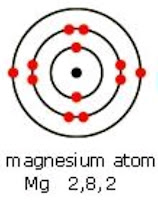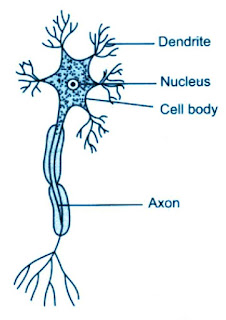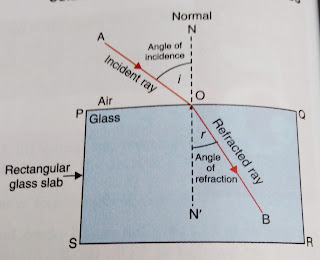NCERT Solution for Class 10 Science : Ch 3 Metals and Non-Metals
Discussed NCERT solution of class 10 subject science of chapter 3 named metals and nonmetals. All questions, answers, notes, PDF are available here.
Exercise Question 1:
Which of the following pairs will give displacement reactions?
(a) NaCl solution and copper metal
(b) MgCl2 solution and aluminium metal
(c) FeSO4 solution and silver metal
(d) AgNO3 solution and copper metal.
Answer 1:
(d) AgNO3 solution and copper metalw
Exercise Question 1:
Which of the following pairs will give displacement reactions?
(a) NaCl solution and copper metal
(b) MgCl2 solution and aluminium metal
(c) FeSO4 solution and silver metal
(d) AgNO3 solution and copper metal.
Answer 1:
(d) AgNO3 solution and copper metalw
You may Like
Question 2:
Which of the following methods is suitable for preventing an iron frying pan from rusting?
(a) Applying grease
(b) Applying paint
(c) Applying a coating of zinc
(d) All of the above.
Answer 2:
(c) Applying a coating of zinc
Question 3:
An element reacts with oxygen to give a compound with a high melting point. This compound is also soluble in water. The element is likely to be
(a) calcium
(b) carbon
(c) silicon
(d) iron
Answer 3:
(a) The element is calcium.
Question 4:
Food cans are coated with tin and not with zinc because
(a) zinc is costlier than tin.
(b) zinc has a higher melting point than tin.
(c) zinc is more reactive than tin.
(d) zinc is less reactive than tin.
Answer 4:
(c) Food cans are coated with tin and not with zinc because zinc is more reactive than tin.
Question 5:
You are given a hammer, a battery, a bulb, wires and a switch.
(a) How could you use them to distinguish between samples of metals and non-metals?
(b) Assess the usefulness of these tests in distinguishing between metals and non– metals.
Answer 5:
(a) using hammer, we try to the sample beat into a sheet. If the sample turns into a seat done it is a metal otherwise the sample is non metal.
Similarly using a battery ,bulb ,wires and switch and the sample object make a circuit. Then if the bulb is glow when switch on, then the sample object is metal otherwise it is non metal.
(b) on the basis of physical properties of metal that is metal is malleable and good conductor of electricity we can distinguish them. Here no chemical properties involved to test them.
Question 6:
What are amphoteric oxides? Give two examples of amphoteric oxides.
Answer 6:
The metal oxides which reacts both acids and bases to form salt and water are called amphoteric oxides. Example aluminium oxide and zinc oxide.
Al2O3(metal oxide) + 6HCl (acid)→ 2AlCl3 (salt)+ 3H2O
(water)
Al2O3 (metal oxide)+ 2NaOH(base) → 2NaAlO2(salt) + H2O (water)
Question 7:
Name two metals which will displace hydrogen from dilute acids, and two metals which will not.
Answer 7:
(The metals which are lie above the hydrogen in reactivity series are replace hydrogen from acids and the metals which are lie below hydrogen in chemical reactivity series do not replace hydrogen from acid)
Two metals which can produce hydrogen or Sodium and potassium.
Two metals which cannot produce hydrogen from acids are Copper and silver.
Question 8:
In the electrolytic refining of a metal M, what would you take as the anode, the cathode and the electrolyte?
Answer 8:
In the electrolytic refining of a metal M:
Anode → Impure metal M
Cathode → Thin strip of pure metal M
Electrolyte → Solution of salt of that metal M
Question 9:
Pratyush took sulphur powder on a spatula and heated it. He collected the gas evolved by inverting a test tube over it, as shown in figure below.
(a) What will be the action of gas on
(i) dry litmus paper?
(ii) moist litmus paper?
(b) Write a balanced chemical equation for the reaction taking place.
Answer 9:
(a) (i) There will be no action( that is no colour change) on dry litmus paper.
(ii) Since the gas is sulphur dioxide (SO2), it turns moist blue litmus paper to red because sulphur dioxide reacts with moisture to form sulphurous acid and shows acidic property.
Question 10:
State two ways to prevent the rusting of iron.
Answer 10:
Two ways to prevent rusting iron are:
(i) by galvanisation
(ii) by oiling, greasing,painting.
Question 11:
What type of oxides is formed when non-metals combine with oxygen?
Answer 11:
Non-metals combine with oxygen to form acidic and neutral oxides.
For example:Sulphur dioxide, carbon dioxide are acidic oxide and carbon monoxide, nitric oxide are neutral oxide.
Question 12:
Give reasons
(a) Platinum, gold and silver are used to make jewellery.
(b)Sodium, potassium and lithium are stored under oil.
(c) Aluminium is a highly reactive metal, yet it is used to make utensils for cooking.
(d)Carbonate and sulphide ores are usually converted into oxides during the process of extraction.
Answer:
(a) since Platinum gold and silver lie bottom of reactivity series, they do not react with others easily and do not get corrode. Again they are lustrous. Because of this to property, Platinum gold and silver are used to make Jewellery.
(b) since sodium lie at the top of reactivity series, it is most reactive and can react with moisture and carbon dioxide present in air. Because of these sodium stored under kerosene.
(c) Aluminium is reactive metal but when it reacts with oxygen present in air form a sticky, stable layer of aluminium oxide which prevent it from further corrosion. Moreover Aluminium is light in weight and good conductor of heat. Because of this aluminium is used in making utensils.
(d) metals can easily extracted from bauxite rather than sulphide and carbonates. Because of this carbonates and sulphide ores fast converted into their oxides.
Question 14:
Differentiate between metal and non-metal on the basis of their chemical properties.
Answer:
Metal. . Non-metals
(i) they form basic oxide. (i) they form acidic
. Or neutral oxides.
(ii) they react with water. (ii) they do not react
and produce hydrogen. . water.
(iii) they act as reducing (iii) they act as
agent. . oxidising agent
(iv) they generally react. (iv) they generally
with acids to form . do not react with
hydrogen. Except . acids.
Cu, Pb,Au,Ag,Pt.
Question 15:
A man went door to door posing as a goldsmith. He promised to bring back the
glitter of old and dull gold ornaments. An unsuspecting lady gave a set of gold bangles to him which he dipped in a particular solution. The bangles sparkled like new but their weight was reduced drastically. The lady was upset but after a futile argument the man beat a hasty retreat. Can you play the detective to find out the nature of the solution he had used?
Answer 15:
He used aqua regia (note: Aqua regia is a solution made up of three part of concentrated hydrochloric acid and one part of concentrated nitric acid. It can dissolve all metals along with Noble metals like gold silver Platinum). When he dipped the gold ornament into the Aqua regia, its upper layer gets dissolved and inner shiny layer coming out. Because of this the weight of bangles get reduced and it become lustrous.
Question 16:
Give reasons why copper is used to make hot water tanks and not steel (an alloy of iron).
Answer 16:
Since copper live at the bottom of reactivity series it do not react with cold and hot water. On the other hand iron lie ever copper in reactivity series and it react with hot water. Because of these copper is used to make hot water tank.
NCERT solution page 14
Question 1:
Give an example of a metal which
(i) is a liquid at room temperature.
(ii) can be easily cut with a knife.
(iii) is the best conductor of heat.
(iv) is a poor conductor of heat.
Answer 1:
(i) A metal which is liquid at room temperature is mercury.
(ii) A metal that can be easily cut by knife is Sodium or potassium.
(iii) A metal which is good conductor of heat is silver.
(iv) A metal which is bad conductor of heat is Lead.
Question 2:
Explain the meanings of malleable and ductile.
Answer 2:
Malleable: it is a property of a substance due to which it can be converted into sheet by hammering. Metals are generally malleable. Among the metals, gold and silver have maximum malleable property.
Ductile: it is the property of a substance due to hooch it can convert it into string by stretching it. Metals are generally ductile. Among them gold has maximum ductile property.
NCERT solution class 8 science page 46:
Question 1:
Why is sodium kept immersed in kerosene oil?
Answer 1:
Sodium lies at the top of the chemical reactivity series. Hence it is very reactive element. it can react with moisture and carbon dioxide present in atmosphere. To prevent this direct contact of sodium, it stored under kerosene.
Question 2:
Write equations for the reactions of
(i) iron with steam
(ii) calcium and potassium with water
Answer 2:
(i) Iron react with steam to form the iron oxide (ferroso ferric oxide) and hydrogen.
3Fe(s) + 4H2O(g) → Fe3O4(s) + 4H2(g)
(ii) (a) The reaction of calcium with water is exothermic reaction and forms calcium hydroxide and hydrogen gas.
Ca(s) + 2H2O(l) → Ca(OH)2(aq) + H2(g)
Potassium react violently with cold water and forms potassium hydroxide and hydrogen gas.The reaction is so violent and exothermic that the evolved hydrogen immediately catches fire.
2K(s) + 2H2O(l) → 2KOH(aq) + H2(g) + heat energy
Question 3:
Samples of four metals A, B, C and D were taken and added to the following solution one by one. The results obtained have been tabulated as follows.
Use the Table above to answer the following questions about metals A, B, C and D.
(i) Which is the most reactive metal?
(ii) What would you observe if B is added to a solution of Copper (II) sulphate?
(iii) Arrange the metals A, B, C and D in the order of decreasing reactivity.
Answer 3:
(i) in reactivity series, iron lies at top then copper then silver. Therefore, iron is most reactive among them and B element displace iron from its sulphate. Therefore B is most reactive element.
(ii) according to reactivity series iron is more reactive than copper. Again element B is more reactive than iron. Therefore iron displace copper from copper sulphate.
(iii) from above discussion we know b is most reactive element and since D unable to this place any metal show it is least reactive element. Copper is more reactive than Silver and metal A can displace Copper, so A is more reactive than C.Hence, the order of decreasing reactivity is B > A > C > D
Question 4:
Which gas is produced when dilute hydrochloric acid is added to a reactive metal? Write the chemical reaction when iron reacts with dilute sulphuric acid (H2SO4).
Answer 4:
When a reactive metal reacts with dilute hydrochloric acid it form hydrogen gas.
Reactive Metal + Dilute acid → Salt + Hydrogen (gas)
When iron react with sulphuric acid it forms iron sulphate and hydrogen.
Fe + H2SO4 → FeSO4+ H2
Question 5:
What would you observe when zinc is added to a solution of iron (II) sulphate? Write the chemical reaction that takes place.
Answer 5:
Since zinc lies above the iron in reactivity series than zinc is more reactive than iron. When we add zinc to iron (II) sulphate solution, zinc displace iron from iron sulphate. It is a displacement reaction
Zn(s) + FeSO4(aq) → ZnSO4(aq) + Fe
NCERT: metal and nonmetal: page 49:
Question 1:
(i) Write the electron-dot structures for sodium, oxygen and magnesium.
(ii) Show the formation of Na2O and MgO by the transfer of electrons.
(iii) What are the ions present in these compounds?
Answer 1:
(a) Electron – dot structure of Sodium:
(b) electron dot structure of oxygen:
(c) electron dot structure of magnesium:
(ii) Formation of sodium oxide Na2O:
Formation of magnesium oxide MgO:
(iii) Ions present in sodium oxide or sodium mono positive. And oxygen ion
Ions present in magnesium oxide or magnesium and oxygen ion.
Question 2:
Why do ionic compounds have high melting points?
Answer 2:
Ionic compounds are consists of opposite charged ions which are strongly held bye electrostatic attraction force. Hence melting point of ionic compounds high.
NCERT solution page 53:
Question 1:
Define the following terms.
(i) Mineral. (ii) Ore. (iii) Gangue.
Answer 1:
(i) Mineral:The natural materials in which the metals or their compounds are found in earth are called minerals.
(ii). Ore: the minerals from which the metals can be extracted conveniently and profitably are called ores.
(iii). Gangue: the impurities such as soil sent etc which are present in ore called Gangue.
Question 2:
Name two metals which are found in nature in the free state.
Answer 2:
two metals which are found in nature as free state are gold and silver.
Question 3:
What chemical process is used for obtaining a metal from its oxide?
Answer 3:
(i) the metals which are at the nearly bottom position of reactivity series are very on the active. This metals are extracted from their oxide by hitting their oxide.
2HgO = 2Hg + O2
(ii) the metals which are at the middle of reactivity series are reactive and these metals are extracted from their oxide by using suitable reducing agent like carbon, hydrogen.
ZnO + C = Zn + CO
(iii) metals which are at the top of reactivity series very reactive and this metal extracted from their oxide by electrolysis process.
NCERT solution text book page 55:
Question 1:
Metallic oxides of zinc, magnesium and copper were heated with the following metals.
Answer:
Question 2:
Which metals do not corrode easily?
Answer 2:
the metals which are at the bottom of reactivity series are unreactive. Such metals are called Noble metal. Example of noble metal which do not corrode easily are gold silver Platinum.
Question 3:
What are alloys?
Answer 3:
An alloy is a homogeneous mixture of two or more metals, or a metal and a non-metal.For example: stainless steel, brass, Bronze,solder.
NCERT Solution for Class 10 Science : Ch 3 Metals and Non-Metals












